Roman Republic M. Plaetorius M. f. Cestianus moneyer
Silver Quinarius 15mm (1.62 grams) Rome, circa 98 B.C.
Reference: Cloulia 2a; B.M.C. 1096-1104; Syd. 586a; Craw. 332/1b
Head of Jupiter right, letter behind head.
Victory standing right, crowning a trophy placed on a Gaulish captive, T . CLOVLI in field, Q in exergue. You are bidding on the exact item pictured, provided with a Certificate of Authenticity and Lifetime Guarantee of Authenticity.
 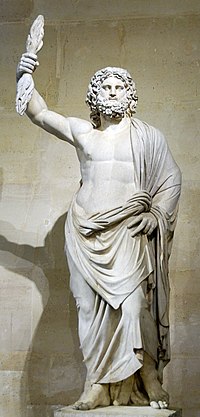 In Roman mythology, Jupiter or Jove was the king of the gods, and the god of sky and thunder. He is the equivalent of Zeus in the Greek pantheon. He was called Iuppiter (or Diespiter) Optimus Maximus ("Father God the Best and Greatest"). As the patron deity of ancient Rome, he ruled over laws and social order. He was the chief god of the Capitoline Triad, with sister/wife Juno. Jupiter is also the father of the god Mars with Juno. Therefore, Jupiter is the grandfather of Romulus and Remus, the legendary founders of Rome. Jupiter was venerated in ancient Roman religion, and is still venerated in Roman Neopaganism. He is a son of Saturn, along with brothers Neptune and Pluto. He is also the brother/husband of Ceres (daughter of Saturn and mother of Proserpina), brother of Veritas (daughter of Saturn), and father of Mercury. In Roman mythology, Jupiter or Jove was the king of the gods, and the god of sky and thunder. He is the equivalent of Zeus in the Greek pantheon. He was called Iuppiter (or Diespiter) Optimus Maximus ("Father God the Best and Greatest"). As the patron deity of ancient Rome, he ruled over laws and social order. He was the chief god of the Capitoline Triad, with sister/wife Juno. Jupiter is also the father of the god Mars with Juno. Therefore, Jupiter is the grandfather of Romulus and Remus, the legendary founders of Rome. Jupiter was venerated in ancient Roman religion, and is still venerated in Roman Neopaganism. He is a son of Saturn, along with brothers Neptune and Pluto. He is also the brother/husband of Ceres (daughter of Saturn and mother of Proserpina), brother of Veritas (daughter of Saturn), and father of Mercury.
The Roman Republic (Latin: Res Publica Romana) was the period of the ancient Roman civilization when the government operated as a republic. It began with the overthrow of the Roman monarchy, traditionally dated around 509 BC, and its replacement by a government headed by two consuls, elected annually by the citizens and advised by a senate. A complex constitution gradually developed, centered on the principles of a separation of powers and checks and balances. Except in times of dire national emergency, public offices were limited to one year, so that, in theory at least, no single individual could dominate his fellow citizens. 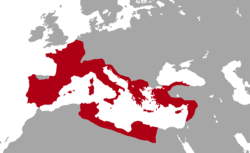
Roman provinces on the eve of the assassination of Julius Caesar, 44 BC Roman society was hierarchical. The evolution of the Constitution of the Roman Republic was heavily influenced by the struggle between the patricians, Rome's land-holding aristocracy, who traced their ancestry back to the early history of the Roman kingdom, and the plebeians, the far more numerous citizen-commoners. Over time, the laws that gave patricians exclusive rights to Rome's highest offices were repealed or weakened, and a new aristocracy emerged from among the plebeian class. The leaders of the Republic developed a strong tradition and morality requiring public service and patronage in peace and war, making military and political success inextricably linked. During the first two centuries of its existence the Republic expanded through a combination of conquest and alliance, from central Italy to the entire Italian peninsula. By the following century it included North Africa, the Iberian Peninsula, Greece, and what is now southern France. Two centuries after that, towards the end of the 1st century BC, it included the rest of modern France, and much of the eastern Mediterranean. By this time, despite the Republic's traditional and lawful constraints against any individual's acquisition of permanent political powers, Roman politics was dominated by a small number of Roman leaders, their uneasy alliances punctuated by a series of civil wars. The victor in one of these civil wars, Octavian, reformed the Republic as a Principate, with himself as Rome's "first citizen" (princeps). The Senate continued to sit and debate. Annual magistrates were elected as before, but final decisions on matters of policy, warfare, diplomacy and appointments were privileged to the princeps as "first among equals" later to be known as imperator due to the holding of imperium, from which the term emperor is derived. His powers were monarchic in all but name, and he held them for his lifetime, on behalf of the Senate and people of Rome. The Roman Republic was never restored, but neither was it abolished, so the exact date of the transition to the Roman Empire is a matter of interpretation. Historians have variously proposed the appointment of Julius Caesar as perpetual dictator in 44 BC, the defeat of Mark Antony at the Battle of Actium in 31 BC, and the Roman Senate's grant of extraordinary powers to Octavian under the first settlement and his adopting the title Augustus in 27 BC, as the defining event ending the Republic. Many of Rome's legal and legislative structures can still be observed throughout Europe and much of the world in modern nation states and international organizations. Latin, the language of the Romans, has influenced language across parts of Europe and the world. The Constitution of the Roman Republic was an unwritten set of guidelines and principles passed down mainly through precedent. The Roman constitution was not formal or even official. It was largely unwritten, uncodified, and constantly evolving. Caesar's early campaigns (59-50 BC) 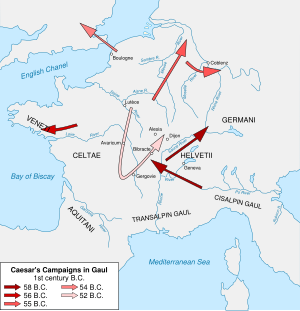
Map of the Gallic Wars
During a term as praetor in the Iberian Peninsula (modern Portugal and Spain), Pompey's contemporary Julius Caesar defeated two local tribes in battle. Following his term as consul in 59 BC, he was then appointed to a five-year term as the proconsular Governor of Cisalpine Gaul (current northern Italy), Transalpine Gaul (current southern France) and Illyria (the modern Balkans). Not content with an idle governorship, Caesar strove to find reason to invade Gaul, which would give him the dramatic military success he sought. When two local tribes began to migrate on a route that would take them near (not into) the Roman province of Transalpine Gaul, Caesar had the barely sufficient excuse he needed for his Gallic Wars, fought between 58 BC and 49 BC. Caesar defeated large armies at major battles 58 BC and 57 BC. In 55 and 54 BC he made two expeditions into Britain, becoming the first Roman to do so. Caesar then defeated a union of Gauls at the Battle of Alesia, completing the Roman conquest of Transalpine Gaul. By 50 BC, the entirety of Gaul lay in Roman hands. Gaul never regained its Celtic identity, never attempted another nationalist rebellion, and, other than the crisis of the 3rd century, remained loyal to Rome until the fall of the western empire in 476. Triumvirates and Caesarian ascension (53-30 BC) By 59 BC an unofficial political alliance known as the First Triumvirate was formed between Gaius Julius Caesar, Marcus Licinius Crassus, and Gnaeus Pompeius Magnus ("Pompey the Great") to share power and influence. In 53 BC, Crassus launched a Roman invasion of the Parthian Empire (modern Iraq and Iran). After initial successes, he marched his army deep into the desert; but here his army was cut off deep in enemy territory, surrounded and slaughtered at the Battle of Carrhae in which Crassus himself perished. The death of Crassus removed some of the balance in the Triumvirate and, consequently, Caesar and Pompey began to move apart. While Caesar was fighting in Gaul, Pompey proceeded with a legislative agenda for Rome that revealed that he was at best ambivalent towards Caesar and perhaps now covertly allied with Caesar's political enemies. In 51 BC, some Roman senators demanded that Caesar not be permitted to stand for consul unless he turned over control of his armies to the state, which would have left Caesar defenceless before his enemies. Caesar chose civil war over laying down his command and facing trial. By the spring of 49 BC, the hardened legions of Caesar crossed the river Rubicon and swept down the Italian peninsula towards Rome, while Pompey ordered the abandonment of Rome. Afterwards Caesar turned his attention to the Pompeian stronghold of Iberia (modern Spain) but decided to tackle Pompey himself in Greece. Pompey initially defeated Caesar, but failed to follow up on the victory, and was decisively defeated at the Battle of Pharsalus in 48 BC, despite outnumbering Caesar's forces two to one, albeit with inferior quality troops. Pompey fled again, this time to Egypt, where he was murdered. Pompey's death did not result in an end to the civil war as Caesar's enemies were manifold and continued to fight on. In 46 BC Caesar lost perhaps as much as a third of his army, but ultimately came back to defeat the Pompeian army of Metellus Scipio in the Battle of Thapsus, after which the Pompeians retreated yet again to Iberia. Caesar then defeated the combined Pompeian forces at the Battle of Munda. Caesar was now the primary figure of the Roman state, enforcing and entrenching his powers and his enemies feared that he had ambitions to become an autocratic ruler. Arguing that the Roman Republic was in danger a group of senators hatched a conspiracy and murdered Caesar in the Senate in March 44 BC. Mark Antony, Caesar's lieutenant, condemned Caesar's assassination, and war broke out between the two factions. Antony was denounced as a public enemy, and Caesar's adopted son and chosen heir, Gaius Octavian, was entrusted with the command of the war against him. At the Battle of Mutina Antony was defeated by the consuls Hirtius and Pansa, who were both killed. Octavian came to terms with Caesarians Antony and Lepidus in 43 BC when the Second Triumvirate was formed. In 42 BC Triumvirs Mark Antony and Octavian fought the Battle of Philippi with Caesar's assassins Brutus and Cassius. Although Brutus defeated Octavian, Antony defeated Cassius, who committed suicide. Brutus joined him shortly afterwards. However, civil war flared again when the Second Triumvirate of Octavian, Lepidus and Mark Antony failed. The ambitious Octavian built a power base of patronage and then launched a campaign against Mark Antony. At the naval Battle of Actium off the coast of Greece, Octavian decisively defeated Antony and Cleopatra. Octavian was granted a series of special powers including sole "imperium" within the city of Rome, permanent consular powers and credit for every Roman military victory, since all future generals were assumed to be acting under his command. In 27 BC Octavian was granted the use of the names "Augustus" and "Princeps" indicating his primary status above all other Romans, and he adopted the title "Imperator Caesar" making him the first Roman Emperor.
|
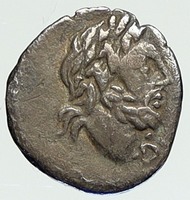
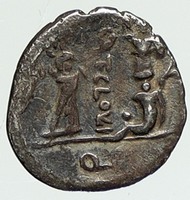

 In Roman mythology, Jupiter or Jove was the king of the gods, and the god of sky and thunder. He is the equivalent of Zeus in the Greek pantheon. He was called Iuppiter (or Diespiter) Optimus Maximus ("Father God the Best and Greatest"). As the patron deity of ancient Rome, he ruled over laws and social order. He was the chief god of the Capitoline Triad, with sister/wife Juno. Jupiter is also the father of the god Mars with Juno. Therefore, Jupiter is the grandfather of Romulus and Remus, the legendary founders of Rome. Jupiter was venerated in ancient Roman religion, and is still venerated in Roman Neopaganism. He is a son of Saturn, along with brothers Neptune and Pluto. He is also the brother/husband of Ceres (daughter of Saturn and mother of Proserpina), brother of Veritas (daughter of Saturn), and father of Mercury.
In Roman mythology, Jupiter or Jove was the king of the gods, and the god of sky and thunder. He is the equivalent of Zeus in the Greek pantheon. He was called Iuppiter (or Diespiter) Optimus Maximus ("Father God the Best and Greatest"). As the patron deity of ancient Rome, he ruled over laws and social order. He was the chief god of the Capitoline Triad, with sister/wife Juno. Jupiter is also the father of the god Mars with Juno. Therefore, Jupiter is the grandfather of Romulus and Remus, the legendary founders of Rome. Jupiter was venerated in ancient Roman religion, and is still venerated in Roman Neopaganism. He is a son of Saturn, along with brothers Neptune and Pluto. He is also the brother/husband of Ceres (daughter of Saturn and mother of Proserpina), brother of Veritas (daughter of Saturn), and father of Mercury.


